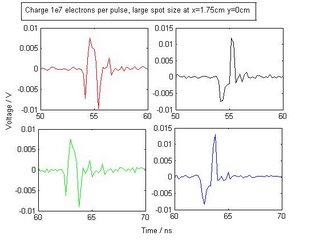Staggering
A better picture of the beam hitting the scintillator. Does anyone remember learning what happens when electrons break the speed of light in a medium? Blue Cherenkov light. Mmm. Look it up. Anyway, it is way off centre here. This nifty piece of instrumentation was essential to get the beam on target to hit the carbon and lead (within the annulus between the red and black lines).

What the output should be:
 What it was after I destroyed the signals with carbon and lead. Mwah ha ha ha ha. And they said it could never be done! They said the effect would be small! They were... well, actually I have no idea what this means. Dammit, now I have to do some thinking.
What it was after I destroyed the signals with carbon and lead. Mwah ha ha ha ha. And they said it could never be done! They said the effect would be small! They were... well, actually I have no idea what this means. Dammit, now I have to do some thinking.

10 Comments:
I know nothing about what you're actually doing, but it sure does look pretty.
*stares*
*nods and smiles*
Yes, I understand... yeah...
I'll just go with pretty as well.
Lovely lights.
Groovy graphs.
Klever Kep.
*as first non-arts person in thread, wishes she could understand and sound all clever too but will settle for just writing more*
Look it up.
I actually did yesterday. But the problem with understanding a teensy tiny bit of what you are doing is that I now need to understand way more. Voltage across what?
Certainly looks like you've upset its ordered world a bit, though. Well done you.
What voltage? No voltage in Cherenkov light...
My voltages? They are on striplines. Pieces of metal. What happens when electrons are whizzing past striplines? They cause image charges. Charge means current and current means voltage therefore you get a signal that depends on how many electrons whizz past and also how close they are to the metal strips. But after I mess the beam up considerably, we don't get electrons just whizzing past. We get a whole shower of electrons and positrons and photons hitting the strips and causing signals that we don't want. People didn't actually think that the unwanted signals would be large but look- they are large and weird. Of course, it may be that there is something wrong with the setup and what I am seeing here has nothing to do with the electrons and positrons from the carbon and lead. Sigh. But I think it must be... I mean, what else is there?
Are the first set of graphs actual ones from when the carbon and lead weren't there, or are they just textbook? Cos if they're actual then...yeah. Must be, surely? And even if not then...unless the beam is doing something really really weird to itself...oh I'm going to stop pretending and go away.
Rian is pleased for Keppet but rather afraid science is a minion of maths, and thusly Rian unappreciatable.
The lights, however, make Rian think of space and beyond.
Why carbon and lead? Lead is a big heavy molecule, would have lots of stuff to spit out. But carbon? Just because there is a lot of it about? Are you worried about creating gamma by doing this? I guess this kind of thing generates a lot of gamma anyway? I am so not a physicist...
And honestly I never think much about Cherenkov except as a nifty trick to count [32}P dry in a scint counter.... and here it is, soooo very lovely. Thank you! I will never herenkov count again without thinking of your feild of stars and sword of light with a sapphire star in it's hilt.
skit- there is a hole in the middle of the carbon and lead so we put the beam through the hole and use the BPM striplines to get those clean signals in the top plot.
Then we move the beam so it hits the material and look at the signals.
The material was chosen to mimick material in a certain region of a linear accelerator. The carbon is "low Z" so particles when they hit it are slowed through scattering and lose energy but they do not tend to create new particles. In this region of the accelerator, we do not want the creation of particles as it would be a huge source of noise. After this "low Z mask" there is a lot of heavy material. Not lead actually but tungsten and other things like silicon. This is such a high Z that particles are stopped in the material. This way, people can get energy measurements (because all of the energy of a particle is deposited). But it also causes showering of new particles. These new particles may escape the high Z material and go on to cause noise in other instruments. It is this noise we are worried about. Does it exist and if so it is large? Will it cause a problem with our readings?
The second plot shows that there is a problem. But some people wonder if the problem we are creating here actually is the same as the problem that would be created in the accelerator.
Oh and the accelerator won't be built until 2018 so people would like to know whether this is an issue now while they can still change the design.
I hope that answers Heather's question as well... Yes, there are lots of gammas/photons. Obviously it is a lot easier to explain the experiment when I have a few chapters of thesis to explain it in. Explaining it in a comment box is kind of hard.
Thankyou! A cool and useful experiment. In truth I probably would not be able to understand your thesis. But at some point I would be willing to try.
Post a Comment
<< Home